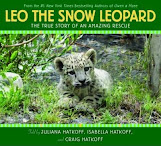Nearly all the pug books in the library have been borrowed and the display is looking very sad and depleted, so yesterday we went looking for another day to celebrate with books...dada...Snow Leopard Day! We had a dozen or so books and a plush toy so it was easy to do. By the time we closed many of these had been borrowed by parents after school too.
Snow leopards are sparsely distributed across 12 countries in central Asia, from southern Russia down to the Tibetan plateau, including Mongolia, China, Afghanistan, Pakistan, India and Nepal. They’re usually at home in high, rugged mountain landscapes at heights of over 3,000 metres – and climate change may shrink their available habitat.
Fascinating Facts About Snow Leopards
- Snow leopards are able to prey on animals that are up to three times their own body weight.
- They have massive, thick tails, which are able to help them maintain balance and shield them from harsh weather. Their tails are almost as long as their entire body.
- A study from the WWF has recorded snow leopards living at 5,859 meters above sea level. This is the highest altitude that has ever been documented for big cats. This is about the same height as the highest mountain in Canada.
- You may be surprised to learn that snow leopards are not able to roar. Instead, they mew, yowl, and growl. They also prusten, which is also known as chuffing. This is a non-threatening vocalization, which is made when they blow air through their nose.
- The fur on the stomach of a snow leopard is almost five inches thick. This is so that they can survive in the harsh and cold mountain climates.
- These animals are often referred to as ‘ghosts of the mountain’ because they spend most of their lives in solitude and they are rarely seen.
- Snow leopards are the only big cats that call Asia’s cold deserts their home. These deserts are sometimes referred to as the third pole because they feature ice fields with the biggest reserves of freshwater outside of the southern and northern polar regions.
There are many graphics like the one below giving this kind go information. There's a very informative video here.
Look for these books:
• Snow Leopards by Victoria Blakemore
• Leo the Snow Leopard by Juliana and Craig Hatkoff
• Saving the Ghost of the Mountain by Sy Montgomery and Nic Bishop
Illustrated:
• Little Mist by Angela McAllister and Sarah Fox-Davies
• Snow Leopards by Nicole Poppenhager and Ivan Gantschev
• Yardil by Roseanne Hawke and Elizabeth Stanley
Novels:
• Zoe's Rescue Zoo: The Lucky Snow Leopard by Amelia Cobb and Sophy Williams
• The Rescue Princesses:The Ice Diamond by Paula Harrison








Such majestic creatures and you have some terrific books for your students.
ReplyDelete